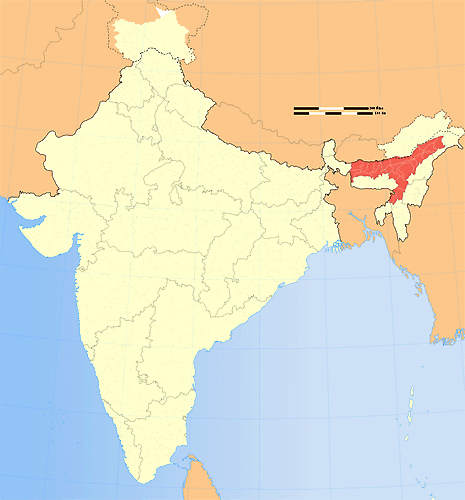
|
|
|
|
BY: SUN STAFF

Citra Bhagavata illustration Satriya School, Assam, c. 1539 A.D. Jan 13, 2012 — CANADA (SUN) — A serial presentation of the Bhakti Movement's development in India. Today, we begin a new series on the development of the Bhakti Movement throughout the India. Gaudiya Vaisnavas have the great good fortune of understanding the most significant manifestation of Bhakti anywhere on the planet – the glorious Appearance of Sri Krsna Chaitanya Mahaprabhu, who is the incomparable personification of the Bhakti Movement. In this series, we will attempt to introduce some of the other great personalities who delivered the Bhakti cult to various regions of the Indian subcontinent. We begin in the far northeastern region of Assam, where the Bhakti Movement was introduced both in the Brahmaputra Valley and in Cooch-Behar by Srimanta Sankaradeva (1449-1568 A.D.). This saint-scholar, playwright and social-religious reformer was a preeminent figure in the cultural and religious history of Assam. Born into a family of non-brahman Bhuyan chiefs, Sankaradeva created a religious bridge between two great Assamese kingdoms, the Ahom and the Koch.
 Assam was known as Pragjyotisha in the Mahabharata, and as Kamarupa in the 1st Millennium. The lineage of Assam's rulers are set down in the Kalika Purana (late 17th c., written in Assam). The earliest ruler of Assam was Mahiranga Danav followed by Hatak, Sambar, Ratna and Ghatak. Naraka brought this line of rulers to an end, and established his own Naraka dynasty. The last of the Naraka-bhauma rulers, Narak, is said to have been slain by Krishna. Naraka's son Bhagadatta, mentioned in the Mahabharata, fought for the Kauravas in the battle of Kurukshetra with an army of kiratas, chinas and dwellers of the eastern coast.

Krishna confronts Naraka, from the manuscript Parijatharan The Koch, a Tibeto-Burmese people, established sovereignty in the region of Assam in 1510 A.D. The Koch kingdom in western Assam and present North Bengal was at its zenith in the early reign of Naranarayana (c. 1540–1587 AD). It split into two around 1581 A.D., with the western part becoming a Mughal vassal and the eastern part an Ahom satellite state. In was in this political atmosphere that the Bhakti saint Sankaradeva did his preaching. Becoming an ascetic during the latter part of his life, Sankaradeva is believed to have visited many places of pilgrimage in north and south India, although most of his mission took place in Assam. He preached absolute devotion to Krishna, and introduced various novel religious processes for spreading the Bhakti cult. His success in pushing the Bhakti Movement forward in Assam is often compared (albeit on a very different level) to Lord Chaitanya's inauguration of the Sankirtan movement in Bengal, and more comparably, to the preaching of Ramananda, Guru Nanak, Kabir, Basava, etc. in other parts of India.

Srimanta Sankaradeva For his philosophical ideals, Sankaradeva faced persecution at the hands of the orthodox brahmanical priesthood of Ahom kingdom, and was forced to take shelter in the territories of the neighbouring Cooch-Behar, where local kings gave him the freedom to preach Bhakti. Sankaradeva's monotheistic presentation of Bhakti came to be known as eka-sarana-dharma (religion of seeking refuge in One). He denounced the caste system and preached to people in the local language, an Assamese form of Brajaboli. Sankaradeva made some significant innovations in devotional practices of the day, such as the inclusion of a dance-drama-music form in the preaching of Bhakti. He also founded the institution of sattra, which refers to an assembly of people of all classes, who join together for religious and social purposes. Later the sattras grew to become full-fledged monasteries, and the sect became known as Mahapurusia- dharma. One modern viewpoint that is often introduced into discussions of the history of religious movements in India is an apologia version of the Mughal influence. Adherents to this viewpoint attempt to attribute the rise of the medieval Bhakti movements, including this one in Assam, to the persecution of Hindus under the Muslim rule. They suggest that Islam was presented to Hindus through its doctrines of unity of god, equality and brotherhood. According to this theory, the Bhakti movements were a two-pronged defensive mechanism to save the Hindu religion by purging it of evils such as the caste system and idolatry, while at the same time defending its basic tenets. The former task is said to have been undertaken by Kabir, Nanak, etc., and the latter project by Tulsidas in the late 16th and early 17th centuries.

Citra Bhagavata illustration Of course, this notion of the medieval Bhakti movements is not at all borne out by evidence. The reality of the Mughal invasion of India was presented in a recent Sun Feature series, "The Mughal Influence on Vaisnavism". Over the course of the 69 segments in this series, we explored the oppressive, violent impact of the Muslim intrusion, demonstrating that the peripheral benefits to Vaisnavism were simply the result of an amalgamation of artistic styles and cultural accoutrement. This is a natural phenomenon when invaders and indigenous people live in close quarters for long periods of time. Vaisnavism flourished in spite of the Mughals, not because of them. This is a point that modern-day preachers of Bhakti should keep clear focus on when interfacing with Islamic and Interfaith elements. (To be continued…) REFERENCES: The Srimanta Sankaradeva Foundation
| |